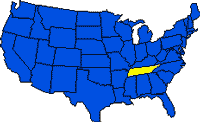
Tennessee State was named for the great river that cuts through the state, although the meaning of the word Tennessee is unknown. From its rough frontier origins Tennessee played an important role in the nation’s history even before statehood in 1796. Tennessee gained its nickname, The Volunteer State, from the large numbers of soldiers it sent to the Revolutionary War, the War of 1812, the Mexican War, and the Civil War. Today Tennessee State is a prosperous state, with much industrial and agricultural potential.
Tennessee State: Land & Resources
 The state’s land surface rolls and tumbles under a variety of climates and vegetation, which mark the three traditional divisions of its territory into East, Middle, and West Tennessee. East Tennessee extends from the GREAT SMOKY MOUNTAINS across a series of elongated ridges and valleys into the CUMBERLAND PLATEAU. In Middle Tennessee the Nashville Basin is rimmed by a heavily carved upland, and West Tennessee contains the Coastal Plain and the Mississippi Bottoms.
The state’s land surface rolls and tumbles under a variety of climates and vegetation, which mark the three traditional divisions of its territory into East, Middle, and West Tennessee. East Tennessee extends from the GREAT SMOKY MOUNTAINS across a series of elongated ridges and valleys into the CUMBERLAND PLATEAU. In Middle Tennessee the Nashville Basin is rimmed by a heavily carved upland, and West Tennessee contains the Coastal Plain and the Mississippi Bottoms.
The physical environment is extremely varied. The Great Smoky Mountains rise to elevations exceeding 1,830 m (6,000 ft), and the range is among the oldest on Earth. Clingmans Dome at 2,025 m (6,643 ft), the highest point in Tennessee, is the second highest point east of the Mississippi River. Eastward from the mountains the Ridge and Valley Province consists of layers of limestone, sandstone, dolomite, and shale, which were crumpled into elongated mountains 400 to 350 million years ago. The mountains’ erosional remnants are the present northeast-southwest trending ridges and intervening valleys. The ridges reach 799 m (2,620 ft) in elevation, and the valleys descend to 195 m (640 ft). Westward of the Ridge and Valley, the Cumberland Plateau varies in width from 80 to 113 km (50 to 70 mi) and in height from 610 to 1,067 m (2,000 to 3,500 ft). Its limestone and sandstone rocks have been deeply cut by streams, and most of the surface is steeply sloped. A spectacular entrenchment about 7 km (4.5 mi) wide and 113 to 129 km (70 to 80 mi) long called the Sequatchie valley occupies the southeastern margin of the plateau.
The plateau drops off sharply to the west into the Nashville Basin. The basin, a rolling, rocky, oval-shaped lowland, averages about 183 m (600 ft) in elevation. It extends approximately 129 km (80 mi) north-south and 80 km (50 mi) east-west. It is surrounded by the Highland Rim, which, with the basin, was eroded from the plateau surface. The Highland Rim stands about 61 to 122 m (200 to 400 ft) higher than the basin and is 32 to 97 km (20 to 60 mi) wide. Most of the surface is gently to steeply sloping.
Farther west is the coastal lowland of West Tennessee. The rocks there are younger, and the surface more level, than any other region in the state. In the northwestern part of Tennessee is Reelfoot Lake, a shallow water body created in 1811-12 by the New Madrid earthquake.
Climate
Tennessee’s climate is transitional between the long, hot summers and mild winters farther south and the more severe winters and shorter summers of the Middle West. January temperatures normally average 5 deg C (41 deg F) in the west and 3 deg C (37 deg F) in the east. July temperatures average 26 deg C (79 deg F) in the west and 22 deg C (71 deg F) in the east. The eastern mountains receive more precipitation (1,270-1,525 mm/50-60 in) than any part of the continental United States except the Pacific Northwest. Statewide precipitation averages 1,270 mm (50 in).
Tennessee State: History
The earliest-known inhabitants of Tennessee were MOUND BUILDERS, and when Europeans penetrated the area they found that these Indian groups were still present. The Spanish explorer Hernando DE SOTO was the first European to enter what is now Tennessee. He crossed the state and discovered (1541) the Mississippi River near present-day Memphis. At that time the CHEROKEE Indians inhabited East Tennessee; the SHAWNEE, Middle Tennessee–apparently on Cherokee sufferance; and the CHICKASAW, West Tennessee. The Chickasaw did not cede West Tennessee until 1818.
Both France and England claimed parts of the territory during the 17th and 18th centuries, but in 1763 the French relinquished all lands east of the Mississippi to England, and permanent European settlement began. In 1772 the settlers in a few isolated centers organized themselves into the WATAUGA ASSOCIATION for protection and administration of justice. Two leaders of this association were John SEVIER and James ROBERTSON, who founded (1779) a community near present-day Nashville.
The Tennessee pioneers joined in the American Revolution, and forces led by Sevier and Isaac SHELBY were instrumental in winning the important Battle of Kings Mountain (Oct. 7, 1780). The victory prevented the joining of two British forces and hastened the surrender of Cornwallis at Yorktown.
Following the Revolution and numerous skirmishes with the Cherokees for control of the territory, the State of FRANKLIN was formed (1784) in eastern Tennessee out of land ceded by North Carolina to the federal government. North Carolina refused to recognize the new state, however, and Sevier, Franklin’s governor, was arrested in 1788 and the new state collapsed. North Carolina again ceded its western territory in 1789, and President Washington commissioned (1790) William BLOUNT governor of all U.S. territory south of the Ohio River. On June 1, 1796, Tennessee became the 16th state; Sevier was its first governor.
In the War of 1812, Tennessee supplied 28,000 troops and had more soldiers than any other state in the Battle of New Orleans, won by native son Andrew JACKSON. Tennessee furnished most of the men and the commanders for the ensuing Indian wars east of the Mississippi. Among the state’s famous Volunteers were Davy CROCKETT, who died at the Alamo, and Gen. Sam HOUSTON, who became the first president of the Republic of Texas.
At the outbreak of the Civil War, Tennessee was torn between the nearly unanimous support of the Union in the abolitionist east and equally strong support of the Confederacy in the slave-holding middle and west. As a result Tennessee was the last Southern state to secede. Because of its position as a border state, more battles of the Civil War were fought on Tennessee territory than any other state except Virginia. After the Union victories at Fort Donelson and Fort Pillow, Tennessee was placed under military rule, with Andrew JOHNSON as military governor.
After the war Tennessee was the first Confederate state to be readmitted to the Union, but Reconstruction proved to be a difficult period in the state’s history. With the election of Democrat John C. Brown as governor in 1870, Reconstruction ended, and nearly a century of Democratic domination of state politics began.
After the Civil War, agriculture made only a slow revival as the state’s economic mainstay, and the ongoing process of industrialization began. In addition to the losses of the war, the population of Memphis was nearly wiped out by a yellow fever epidemic in 1878.
The tiny town of Dayton became the center of national attention in 1925 when the famous SCOPES TRIAL brought together William Jennings Bryan and Clarence S. Darrow in a bitter lawsuit concerning the teaching of Darwin’s theory of evolution. The case was a test of a Tennessee statute (1925) prohibiting the teaching of evolution (which offended religious fundamentalists) in the state’s public school system. The challenge was unsuccessful, and the law remained on the books until 1967.
Tennessean Cordell HULL served as secretary of state under President Franklin ROOSEVELT and received the Nobel Peace Prize. Estes KEFAUVER, elected from Tennessee to the U.S. Senate in 1948, became a leader in struggles for civil rights and against organized crime. Desegregation of public schools proceeded slowly but without serious incident in Tennessee. On Apr. 4, 1968, the Rev. Martin Luther KING, Jr., was assassinated in Memphis.
Today Tennessee still has its traditional contrasts between the industrialized east and the more agricultural west. These distinctions are now more a source of strength than conflict, however. During the 1980s in-migration to the state increased. Tennessee also profited in the 1980s and early 1990s from the introduction of Japanese and American motor-vehicle manufacturing in the state.
Tennessee State: Land
- Area: 109,158 sq km (42,146 sq mi); rank: 36th.
- Capital: Nashville-Davidson (1990 census, 510,784).
- Largest city: Memphis (1990 census, 610,337).
- Counties: 95.
- Elevations: highest–2,025 m (6,643 ft), at Clingmans Dome; lowest–54 m (178 ft), at the Mississippi River.
 Kids Portal For Parents India Kids Network
Kids Portal For Parents India Kids Network










